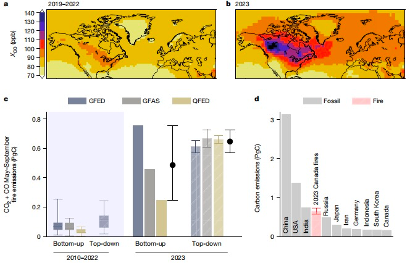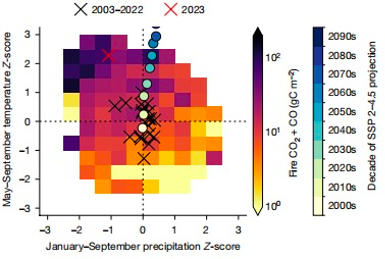Canada's forest fires released more carbon dioxide than Russia and Japan's annual carbon emissions last year
A study by American scientists on forest fires in Canada points out that the carbon emissions of wildfires in Canada in 2023 exceed the annual emissions of seven countries among the world's largest emitters of fossil fuels in 2022, second only to China, India and the United States, and ranking ahead of industrial powers Russia and Japan.

Carbon monoxide enhancement and emission estimates from canadian wildfires.
Studies have shown that widespread hot and dry weather is the main cause of the spread of fires, which inhibits the carbon absorption capacity of Canadian forests and raises concerns about whether forests can serve as long-term carbon sinks. The above results were published in the authoritative scientific journal Nature on August 28, Beijing time.
Canada's forests are an important carbon sink in the world, absorbing more carbon from the atmosphere than they emit. These forests cover a vast area of nearly 362 million hectares, accounting for 8.5% of the global forest area. They play an important role in absorbing carbon dioxide from the atmosphere and slowing down the rate of climate warming. 2015-2020 During 2000, Canada's carbon reserves increased by 366±88.6 million tons of carbon per year, contributing approximately 30% of the net terrestrial carbon sink.
However, the large amount of carbon emissions caused by fires in Canada in 2023 has called into question the sustainability of this carbon sink. Canada's fires in 2023 destroyed more than 15 million hectares of forest, accounting for approximately 4% of Canada's total forest area, and the total area burned is seven times the average of the previous 40 years.
The paper's corresponding author Brendan Byrne and colleagues used an inversion model of satellite observations of carbon monoxide in the smoke plume to quantify the amount of carbon released from fires from May to September 2023. According to their estimates, Canada's forest fire carbon emissions from May to September 2023 reached 647 teragrams (teragram, 1 teragram equals 1 trillion grams). Far exceed the general level of forest fire emissions in Canada and are comparable to India's annual fossil fuel emissions. Over the past 10 years, Canada's average estimate is 29-121 teragrams, which is more than four times Canada's annual fossil fuel emissions.
In addition, the study further discussed concurrent climate anomalies and general changes in hot and dry weather under climate change, and pointed out that hot and dry weather is a major driver of fire activity.
The 2023 fire season in Canadian forests is unusually hot and dry. This is the driest year for Canadian forests from January to September since 1980, with approximately 86% of forest areas receiving lower-than-average rainfall and approximately 52% of regional precipitation falling below the 2003 to 2022 average. One standard deviation of the level. At the same time, May to September 2023 is the warmest period since 1980, with about 100% of forest areas having temperatures above average, and about 90% of areas having temperatures above one standard deviation of the 2003 to 2022 average.
Changes in fire emissions as a function of temperature and precipitation Z-fraction between 2003 and 2023 show a significant increase in fire emissions under abnormally hot and dry conditions. These hot and dry conditions will be more common in 2023 than in previous years, explaining why fire emissions in 2023 are so extreme.

Relationship between fire emissions and climate anomalies.
2023 is Canada's hottest year in nearly four decades. But Byrne and colleagues predict that climate warming will become a trend under the Shared Socio-Economic Path (SSP) of moderate warming. By the 2050s, a significant temperature increase is expected, the water cycle will "accelerate", evaporation and precipitation rates will increase, and the average temperature in the 2050s will be close to 2023 levels.
Climate warming and increased regional humidity gaps may lead to increased carbon emissions from Canadian forest fires. If large-scale fires like the ones in 2023 become the norm, all Canadian forests could burn down every 25 years. As a result, increased forest fire activity in Canada may threaten the carbon sequestration potential of Canadian forests and create uncertainty about their carbon sink role. This will further affect the amount of emissions allowed to achieve climate warming goals, as reduced carbon sequestration by ecosystems must be compensated by adjusting for reductions in anthropogenic emissions.
As a party to the Paris Agreement, Canada is obligated to track economy-wide greenhouse gas (GHG) emissions and removals in its national greenhouse gas emissions inventory (NGHGI). However, the role of Canada's fire management strategy in managing fire carbon emissions is questionable. Fire management strategies need to balance multiple factors, including socio-economic costs, ecological impacts and carbon emissions, while Canada currently adopts a risk-based strategy that determines whether to extinguish the fire based on the specific circumstances of each fire.







